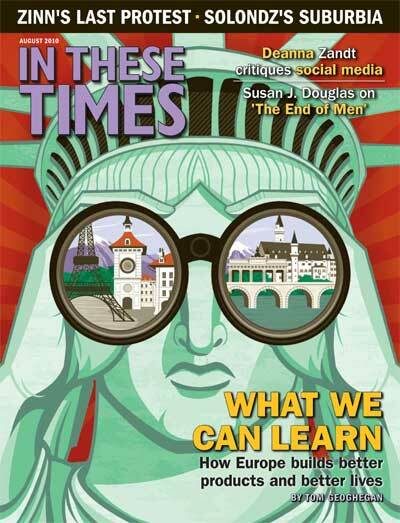
In 2009, the U.S. government dedicated $28.7 billion to foreign aid – more than double what American taxpayers paid for overseas development projects in 2000. But as U.S. development aid rose steadily throughout the last decade, a broad spectrum of development experts, diplomats and aid recipients increasingly agreed that America’s foreign aid system is fundamentally broken.
In the waning days of George W. Bush’s presidency, three former heads of the U.S. Agency for International Development (USAID), the country’s lead development agency, put it bluntly. In the December 2008 Foreign Affairs, J. Brian Atwood, M. Peter McPherson and Andrew Natsios wrote: “[O]rganizational structures and statutes governing [development programs] have become chaotic and incoherent thanks to 20 years of accumulated neglect by both Republicans and Democrats in the executive and legislative branches.”
And since last summer, politicians and government officials – in the House, Senate, State Department and White House – have joined the consensus: U.S. overseas development aid fails to help recipient nations develop their economies and lift poor citizens out of poverty. Washington must reorganize and refocus its aid system – which hasn’t significantly changed in half a century – and it must do so to improve global security.
The ‘three pillars’ theory
The U.S. development community is optimistic that substantial changes to America’s aid system are at hand. And for good reason: President Barack Obama and Secretary of State Hillary Clinton have both been explicit about the need for reform and commissioned comprehensive reviews of U.S. development policies and practices.
Clinton has repeatedly stated her commitment to making defense, diplomacy and development “three equal pillars” of U.S. foreign policy, recognizing that they must work in concert if they are to serve U.S. interests. “Development was once the province of humanitarians, charities, and governments looking to gain allies in global struggles,” Clinton said in January. “Today it is a strategic, economic and moral imperative – as central to advancing American interests and solving global problems as diplomacy or defense.”
Under the Bush administration, critics say USAID lost its capacity to undertake and monitor major projects, most of which were farmed out to private-in some cases for-profit – organizations. To strengthen the agency, Clinton has requested increases to USAID’s budget and increased the agency’s staffing. And in July 2009, she instituted the first-ever State Department Quadrennial Diplomacy and Development Review (QDDR), intended “to define the capabilities we need and then match resources with priorities.” The review is expected to be released early this fall.
Obama, meanwhile, has pledged to double U.S. foreign assistance and modernize it. He promised to “elevate, streamline and empower a 21st century U.S. Development Agency,” and last year began a cross-governmental review of development policy, the Presidential Study Directive on Global Development. He tapped National Security Advisor James Jones and National Economic Development Council Director Lawrence Summers to oversee the effort.
Strikingly absent from this cross-governmental panel was the director of USAID, because at the time there wasn’t one: Rajiv Shah wasn’t confirmed as the agency’s administrator until January 7. Although the lateness of Shah’s appointment may have damaged the impetus for development reform, critics regard his eventual confirmation as another good omen. Reform advocates admire Shah’s commitment to development and his experience outside the beltway. A medical doctor, Shah came to USAID from the Bill & Melinda Gates Foundation, where he was in charge of agricultural development programs.
Reform vs. reality
But some observers think Shah will have a hard time preventing development assistance from being subsumed by emergencies, such as Haiti, and the exigencies of national security. (Just days after his confirmation, Clinton assigned Shah to oversee the country’s Haitian earthquake response.) Despite recent intimations of significant changes, the reality of longstanding U.S. spending habits is daunting.
First, there is the challenge of making the three equal pillars concept a reality. Many consider Clinton’s pillars talk merely a rhetorical flourish, given that the United States currently spends 12.5 times more on defense ($688 billion for the Department of Defense in 2010) than on diplomacy and development combined. Even if Congress approves the proposed budget increase to $56.8 billion for the State Department and foreign assistance, much of the development portion will go to support wars in Afghanistan and Iraq, and to buttress military operations in Pakistan.
Another source of inequality is that USAID is not a cabinet-level agency (like the Defense Department) but instead resides within the State Department. Also, any current or future strengthening of USAID has to be understood in the context of just how weak the agency has become. Under the Bush administration, it saw its share of the country’s “official development aid” (ODA) budget shrink from 60 to 40 percent. Congress, meanwhile, has routinely overwhelmed its budget with earmarks and disperses foreign aid among a dizzying array of government departments, agencies and offices.
Finally, USAID continues to operate under the antiquated Foreign Assistance Act (FAA), which dates back to USAID’s founding under President John F. Kennedy. The FAA is a source of frustration and anger among development experts, and reforming it is the central goal of the Modernizing Foreign Assistance Network (MFAN), which brings together development professionals and organizations, and lobbies to change how Washington conceives of and delivers foreign aid. According to former USAID directors, the FAA burdens USAID with excessive and meaningless reporting. It also contains “buy American” provisions that are costly, and cumbersome, development professionals say.
Congress is beginning to act. In April 2009, Reps. Howard Berman (D-Calif.), chair of the House Foreign Affairs Committee, and Mark Kirk (R-Ill.) introduced the Initiating Foreign Assistance Reform Act of 2009. More than 120 legislators are now co-sponsors. Meanwhile, Sens. John Kerry (D-Mass.) and Richard Lugar (R-Ind.) advanced the Foreign Assistance Revitalization and Accountability Act out of committee in November 2009. It has more than 20 co-sponsors, but has not yet been scheduled for debate on the Senate floor.
While conceding that USAID won’t secure a cabinet-level appointment any time soon, MFAN is working to make sure that what it calls “the Grand Bargain” becomes part of development reform. MFAN member Nora O’Connell, of Women Thrive Worldwide, says this would require Congress to agree to have less say in crafting development agency budgets. In return, USAID and other agencies would become more accountable for project outcomes. “This is hard for the political system” says O’Connell, because it doesn’t fit with political needs or timelines, and would also entail authorizing more long-term projects.
What MFAN co-chairs Rev. David Beckmann of Bread for the World and Dr. George Ingram, former deputy assistant administrator of USAID, last year called the “unprecedented momentum created at all levels of government” has yet to crystallize into actual change.
A promising leak
A May 3 leak of preliminary recommendations to be made by Obama’s Presidential Study Directive does, however, include much of what reformers want. The draft proposes replacing the current haphazard system with a “modern architecture” of government to devise, implement and monitor development projects. It would include the head of USAID at relevant National Security Council meetings and give the agency control over its own budget, though it would still remain within the State Department. If provisions to limit State Department powers remain, as the development community hopes, Obama may clash with Clinton. Her forthcoming review is unlikely to give the power of the purse to USAID.
Reform advocates continue to push the Obama administration, but skeptics return to this: A U.S. military budget equaling 4.6 percent of GDP compared with a development budget of less than 0.2 percent of GDP looks a bit lopsided. Fifty years after USAID’s creation at the height of the Cold War, the U.S. military still reigns supreme as an expression of American foreign policy, and the three equal pillars sought by so much of the development world remain a 21st-century dream.









